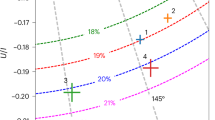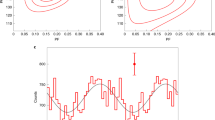Abstract
The millisecond pulsar1 PSR1937 + 21 might be expected to have unique waveform and polarization properties as a result of its remarkably short period and small spin-down rate2,3. The proximity of the velocity of light cylinder to the star (RLC = 7.4 × 106 cm) and the low value of inferred magnetic field (∼108 G, 10−4 that of the Crab pulsar) should strongly influence the magnetospheric structure and particle density of this pulsar. And yet the waveform is similar to that of the Crab pulsar4 and PSR1055 − 52 (ref. 5), which have interpulses that are comparable in strength to the main pulse, and the polarization properties are at first sight unexceptional2. I present here polarization observations of the main pulse and interpulse at 1,415 and 2,380 MHz that have higher time resolution than previously available. The main pulse depolarizes substantially over this frequency range whereas the interpulse polarization almost doubles. There is evidence that orthogonally polarized radiation is present on the leading edge of the main pulse and the trailing edge of the interpulse and that it accounts for the ∼90° difference in position angle between the main pulse and interpulse. The interpulse decreases in intensity relative to the main pulse as f−1, indicating (if the trend continues to lower frequency) that the high frequency interpulse dominates the main pulse below ∼700 MHz. The main pulse is found to consist of two closely spaced components.
This is a preview of subscription content, access via your institution
Access options
Subscribe to this journal
Receive 51 print issues and online access
$199.00 per year
only $3.90 per issue
Buy this article
- Purchase on Springer Link
- Instant access to full article PDF
Prices may be subject to local taxes which are calculated during checkout
Similar content being viewed by others
References
Backer, D. C., Kulkarni, S. R., Heiles, C., Davis, M. M. & Goss, W. M. Nature 300, 615–618 (1982).
Ashworth, M., Lyne, A. G. & Smith, F. G. Nature 301, 313–314 (1983).
Backer, D. C., Kulkarni, S. R. & Taylor, J. H. Nature 301, 314–315 (1983).
Manchester, R. N. Astrophys. J. Lett. 163, L61–L63 (1971).
McCulloch, P. M., Hamilton, P. A., Ables, J. G. & Komesaroff, M. M. Mon. Not. R. astr. Soc. 175, 71P–75P (1976).
Stinebring, D. R., Cordes, J. M., Rankin, J. M., Weisberg, J. M. & Boriakoff, V. Astrophys. J. (submitted,).
Manchester, R. N. & Lyne, A.G. Mon. Not. R. astr. Soc. 181, 761–767 (1977).
Cheng, A. F. & Ruderman, M. A. Astrophys. J. 216, 865–872 (1977).
Hankins, T. H. & Cordes, J. M. Astrophys. J. 249, 241–253 (1981).
Narayan, R. & Vivekanand, M. Nature (submitted).
Rankin, J. M. et al. Astrophys. J. 162, 707–725 (1970).
Author information
Authors and Affiliations
Rights and permissions
About this article
Cite this article
Stinebring, D. Polarimetry of the millisecond pulsar. Nature 302, 690–692 (1983). https://doi.org/10.1038/302690a0
Received:
Accepted:
Published:
Issue Date:
DOI: https://doi.org/10.1038/302690a0
This article is cited by
-
New millisecond pulsar in a binary system
Nature (1986)
-
Millisecond pulsars
Journal of Astrophysics and Astronomy (1984)
-
Low-frequency polarimetry of the millisecond pulsar PSR1937 + 214
Nature (1983)
Comments
By submitting a comment you agree to abide by our Terms and Community Guidelines. If you find something abusive or that does not comply with our terms or guidelines please flag it as inappropriate.



